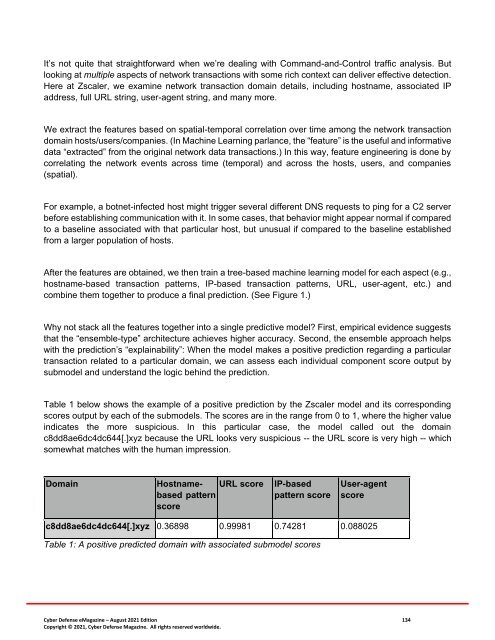Cyber Defense eMagazine August Edition for 2021
Cyber Defense eMagazine August Edition for 2021 #CDM #CYBERDEFENSEMAG @CyberDefenseMag by @Miliefsky a world-renowned cyber security expert and the Publisher of Cyber Defense Magazine as part of the Cyber Defense Media Group as well as Yan Ross, US Editor-in-Chief, Pieruligi Paganini, Co-founder & International Editor-in-Chief, Stevin Miliefsky, President and many more writers, partners and supporters who make this an awesome publication! Thank you all and to our readers! OSINT ROCKS! #CDM #CDMG #OSINT #CYBERSECURITY #INFOSEC #BEST #PRACTICES #TIPS #TECHNIQUES
Cyber Defense eMagazine August Edition for 2021 #CDM #CYBERDEFENSEMAG @CyberDefenseMag by @Miliefsky a world-renowned cyber security expert and the Publisher of Cyber Defense Magazine as part of the Cyber Defense Media Group as well as Yan Ross, US Editor-in-Chief, Pieruligi Paganini, Co-founder & International Editor-in-Chief, Stevin Miliefsky, President and many more writers, partners and supporters who make this an awesome publication! Thank you all and to our readers! OSINT ROCKS! #CDM #CDMG #OSINT #CYBERSECURITY #INFOSEC #BEST #PRACTICES #TIPS #TECHNIQUES
Create successful ePaper yourself
Turn your PDF publications into a flip-book with our unique Google optimized e-Paper software.
It’s not quite that straight<strong>for</strong>ward when we’re dealing with Command-and-Control traffic analysis. But<br />
looking at multiple aspects of network transactions with some rich context can deliver effective detection.<br />
Here at Zscaler, we examine network transaction domain details, including hostname, associated IP<br />
address, full URL string, user-agent string, and many more.<br />
We extract the features based on spatial-temporal correlation over time among the network transaction<br />
domain hosts/users/companies. (In Machine Learning parlance, the “feature” is the useful and in<strong>for</strong>mative<br />
data “extracted” from the original network data transactions.) In this way, feature engineering is done by<br />
correlating the network events across time (temporal) and across the hosts, users, and companies<br />
(spatial).<br />
For example, a botnet-infected host might trigger several different DNS requests to ping <strong>for</strong> a C2 server<br />
be<strong>for</strong>e establishing communication with it. In some cases, that behavior might appear normal if compared<br />
to a baseline associated with that particular host, but unusual if compared to the baseline established<br />
from a larger population of hosts.<br />
After the features are obtained, we then train a tree-based machine learning model <strong>for</strong> each aspect (e.g.,<br />
hostname-based transaction patterns, IP-based transaction patterns, URL, user-agent, etc.) and<br />
combine them together to produce a final prediction. (See Figure 1.)<br />
Why not stack all the features together into a single predictive model? First, empirical evidence suggests<br />
that the “ensemble-type” architecture achieves higher accuracy. Second, the ensemble approach helps<br />
with the prediction’s “explainability”: When the model makes a positive prediction regarding a particular<br />
transaction related to a particular domain, we can assess each individual component score output by<br />
submodel and understand the logic behind the prediction.<br />
Table 1 below shows the example of a positive prediction by the Zscaler model and its corresponding<br />
scores output by each of the submodels. The scores are in the range from 0 to 1, where the higher value<br />
indicates the more suspicious. In this particular case, the model called out the domain<br />
c8dd8ae6dc4dc644[.]xyz because the URL looks very suspicious -- the URL score is very high -- which<br />
somewhat matches with the human impression.<br />
Domain<br />
Hostnamebased<br />
pattern<br />
URL score<br />
score<br />
IP-based<br />
pattern score<br />
User-agent<br />
score<br />
c8dd8ae6dc4dc644[.]xyz 0.36898 0.99981 0.74281 0.088025<br />
Table 1: A positive predicted domain with associated submodel scores<br />
<strong>Cyber</strong> <strong>Defense</strong> <strong>eMagazine</strong> – <strong>August</strong> <strong>2021</strong> <strong>Edition</strong> 134<br />
Copyright © <strong>2021</strong>, <strong>Cyber</strong> <strong>Defense</strong> Magazine. All rights reserved worldwide.


















